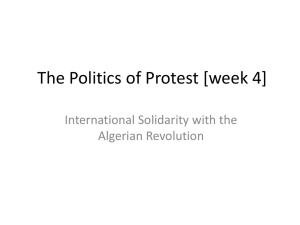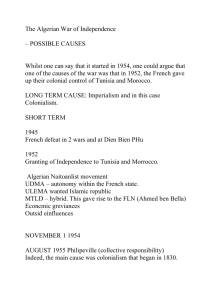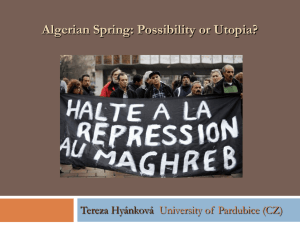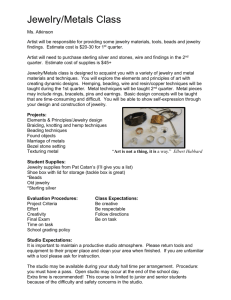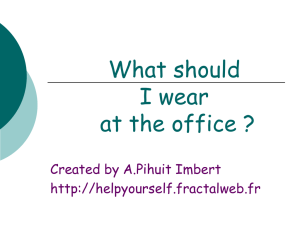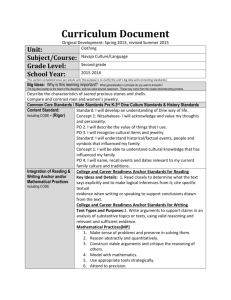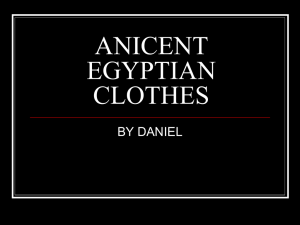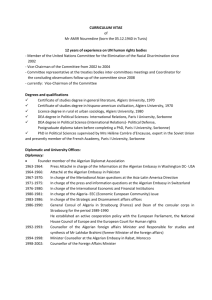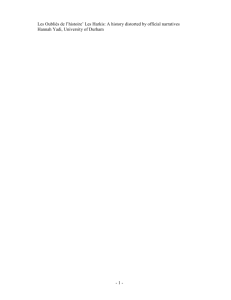Rubrique Culture
advertisement
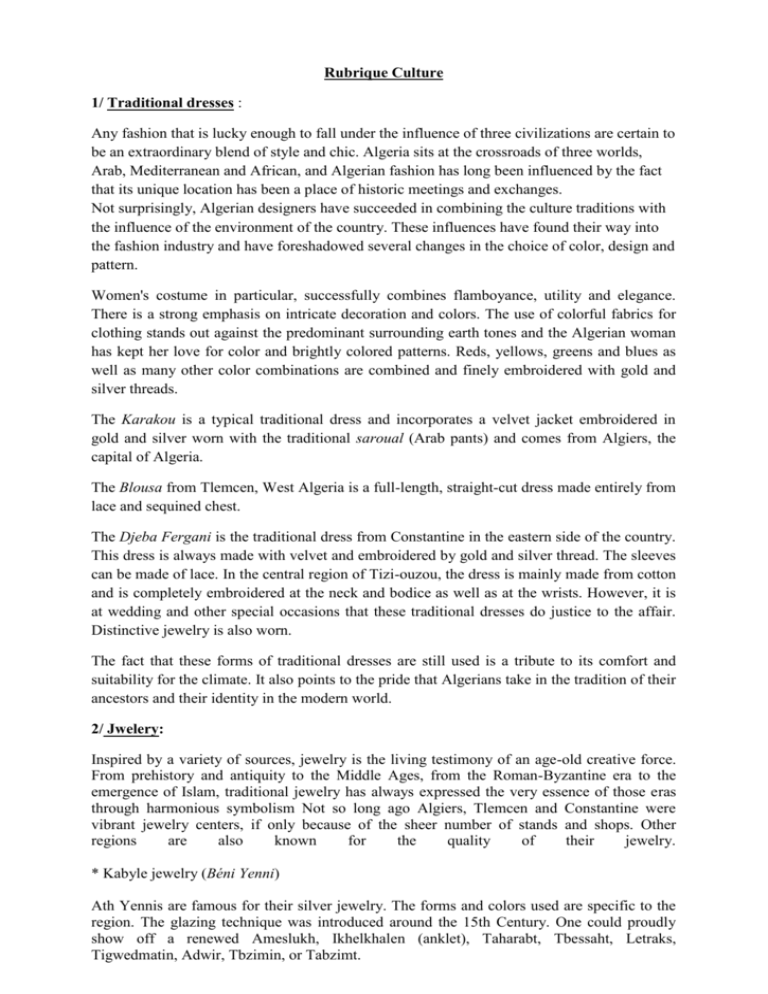
Rubrique Culture 1/ Traditional dresses : Any fashion that is lucky enough to fall under the influence of three civilizations are certain to be an extraordinary blend of style and chic. Algeria sits at the crossroads of three worlds, Arab, Mediterranean and African, and Algerian fashion has long been influenced by the fact that its unique location has been a place of historic meetings and exchanges. Not surprisingly, Algerian designers have succeeded in combining the culture traditions with the influence of the environment of the country. These influences have found their way into the fashion industry and have foreshadowed several changes in the choice of color, design and pattern. Women's costume in particular, successfully combines flamboyance, utility and elegance. There is a strong emphasis on intricate decoration and colors. The use of colorful fabrics for clothing stands out against the predominant surrounding earth tones and the Algerian woman has kept her love for color and brightly colored patterns. Reds, yellows, greens and blues as well as many other color combinations are combined and finely embroidered with gold and silver threads. The Karakou is a typical traditional dress and incorporates a velvet jacket embroidered in gold and silver worn with the traditional saroual (Arab pants) and comes from Algiers, the capital of Algeria. The Blousa from Tlemcen, West Algeria is a full-length, straight-cut dress made entirely from lace and sequined chest. The Djeba Fergani is the traditional dress from Constantine in the eastern side of the country. This dress is always made with velvet and embroidered by gold and silver thread. The sleeves can be made of lace. In the central region of Tizi-ouzou, the dress is mainly made from cotton and is completely embroidered at the neck and bodice as well as at the wrists. However, it is at wedding and other special occasions that these traditional dresses do justice to the affair. Distinctive jewelry is also worn. The fact that these forms of traditional dresses are still used is a tribute to its comfort and suitability for the climate. It also points to the pride that Algerians take in the tradition of their ancestors and their identity in the modern world. 2/ Jwelery: Inspired by a variety of sources, jewelry is the living testimony of an age-old creative force. From prehistory and antiquity to the Middle Ages, from the Roman-Byzantine era to the emergence of Islam, traditional jewelry has always expressed the very essence of those eras through harmonious symbolism Not so long ago Algiers, Tlemcen and Constantine were vibrant jewelry centers, if only because of the sheer number of stands and shops. Other regions are also known for the quality of their jewelry. * Kabyle jewelry (Béni Yenni) Ath Yennis are famous for their silver jewelry. The forms and colors used are specific to the region. The glazing technique was introduced around the 15th Century. One could proudly show off a renewed Ameslukh, Ikhelkhalen (anklet), Taharabt, Tbessaht, Letraks, Tigwedmatin, Adwir, Tbzimin, or Tabzimt. * Chaoui jewelry While of a different shape than Kabyle jewelry, "full" or "hollow" Chaoui jewelry has stood the test of time yet it has managed to preserve its authenticity. It is defined by the "Alaq Tchoutchara" (earring) that is sadly not made anymore, the Timcherreft (also an earring), the Korsa Bel Quota, a more recent creation, "Amquyas," the Abzim, whose close resemblance to the Kabyle fibula can surely be rooted in an obvious ethnic analogy, the Lamessak, a recent creation true to the Chaoui style, the Tinahissin, the Cherketh or Semsem, the khelkhal (ancient ankle bracelet that women from the region never take off), the Guerrar, the Skhab, or necklace, to be found throughout the Mahgreb region. * M'sila jewelry This tradition that very closely resembles Chaoui jewelry of a hybrid style, with Roman and Byzantine external influences, and is based on traditions pertaining to daily life and the environment. Besides the Akhelkhal, one can find Abzims and necklaces whose main characteristic is a close resemblance to Chaoui jewelry, although of a less refined style. * Touareg jewelry This jewelry reflects a well-preserved and wisely maintained tradition, thanks mainly to the legendary Inadens. It attained mythical social status. The Tuareg society is truly devoted to artisans and noble trades, such as jewelry. Its symbolism echoes the perpetual quest of the Tuareg to control natural elements. Pendants, rings, pectorals, earrings, anklets, brass rings, and shell necklaces are all loyal representations of a bygone era. One should also mention the Tareout, Tasralt, Tineralt, Khomessa, Tareout N'azeref, Tiseguin, Ihebsans, and Asarou ouam Afer that combine utility and pleasure reminiscent of nearby Black Africa by their mystical aspects. Tuareg jewelry reflects a constant concern for pure aesthetics. 3/ Painting With artists such as Abdelhalim HEMCHEB, Azouaou MAMMERI, and later Mohamed BOUZID, Bachir YELLES and Ali KHODJA, Algerian paintings of occidental inspiration were quite remarkable, well before Independence. Moreover, thanks to the Racims, Algerian miniature and illuminated art forms developed at an accelerating rate. One must point out the role played by Mohamed Racim in preserving Algerian authentic values. His school suddenly expanded with artists such as Mohamed Temmam, Mohamed Ranem, and Hamminouna as well as new generations of artists who drew inspiration and techniques from this art form. The figurative trend also owes a debt to older artists. Each in their own way, Racim and Dinet have greatly influenced this artistic movement that reflected Algerian traditions, social values and daily life. Baya and Benaboura are representatives of this so-called "naive" painting, which mirrors the Algerian spirit. Zmirli, Samson, Abdoun and many others also adopted this expression of stunning freshness and simplicity. More refined, the creations of Issiakhem breathed new life into the art world and paved the way for the more abstract works of Khadda, Mesli, Benanteur and Guermaz. Finally, many other artistic movements flourished throughout the various Algerian regions such as crude art, "El Aauchem" (sign painting), and "Essebaghines", all represented by artists such as Hakkar, Ammar Bouras, Zineb Sedra, Samta Benyahia and many others. Dalila Orfali, curator of Algiers' Museum of Fine Arts, characterized the Algerian painting of recent years as follows: "The last decade was defined by the intensification of such trends" A major revival of artistic activities within the country, dominated by individual techniques, defined the period between the 1990's and year 2000. As such, symbol-free figurative art forms have made a strong revival. Djemaï, Bourdine, Hafidh, Heinen-Ayech and Chegrane are some of the disciples of this movement. The emerging school of contemporary painting was now spreading to every corner of the globe, carrying a vision which inadvertently rallied historical and cultural heritage patterns such as avant-garde compositions, transient art and others. Moreover, in the early 1990's, in times of extreme hardship, women did not hesitate to affirm themselves through their writings, even as others chose to remain silent: _ Malika Modadem's "L'interdite," 1993 _ Mina Bouraoui's "La voyeuse interdite," 1991 _ Leïla Sebbar's "Le silence des rives," 1993 _ Assia Djebbar's "Loin de Médine," 1992 Nadia Ghalem was published in Canada, while other writers were published in Paris or Damascus. Visual arts provide a diversified landscape, accessible to all, in fields such as miniatures and illumination (Racim, Temmam, Bendebbag, Ghanem and Sahraoui), figurative art (Yellès, Baya, Ali Khodja and Houamel), abstract art (Issiakhem, Khadda, Mesli, Guermaz and Hakkar. As a matter of fact abstract art is quickly becoming the expression of choice for those wishing to illustrate the obscure. Many painters decided to concentrate on landscapes, such as Abderrahman Sahouli, Nedjar Bencheikh, Zermane, Hamchaoui and Chaouane. In the quest for an authentic Algerian pictorial form of expression, some artists were self-taught, some were "naiverealists," and others chose the forms of "photographers." In the eighties, a new generation of artists such as Sid Ahmed Chabane, Slimane Ould Mohamed, Amar Bourras, Yahia Abdel-malek, Myriam Aït Chehara, and Réda Tebib emerged to enhance artistic expression by using new media such as powders, refined tar, pelts, plants, plastics, wood, and cardboard, thus developing an art form permeated by modern technologies. One could hardly find a direct reference to the city's landscape in Nadia Laggoune's "Alger dans la peinture”. 4/ Cooking: Algerian cuisine has a wide range of dishes as varied as each other, the richness and variety of ingredients used in cooking are very popular around the world. Because of the location and the size of Algeria, Algerian cuisine consists of a set of typical specialties of each region of Algeria, it also benefits from refinements and a multitude of foreign influences. Algerian cuisine is also known to be a mother for cooking recipes are often jealously guarded well. Bread (Khobz) is the basis of the Algerian cuisine, it is eaten at every meal, it comes in several genres: Khobz dar, kesra matlouh, kesra m'bessa, kesra rakhsis,... We can say that couscous is the national dish of Algeria, there are approximately more than 150 different preparations of cousous including couscous with vegetables and meat, couscous with milk (mesfouf), couscous with sugar , dates, raisins and eggs (seffa) and many others.
